Insect management
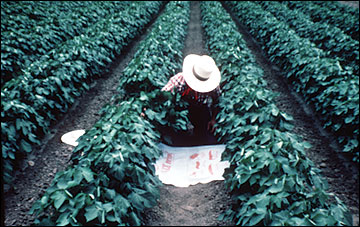 Figure 3
Figure 3
Scouting is the foundation for any pest management program.
From emergence until harvest, various pests attack the roots, leaves, stems or fruit (squares, blooms and bolls) of cotton. Growers and their field scouts must be vigilant in locating these pest outbreaks so that timely control measures can be undertaken (Figure 3). Economic threshold levels have been established for many cotton pests. A threshold infestation is the point at which control measures are needed to prevent the target pest from reaching its economic injury level (when control costs equal damage caused by the pest). The goal should be to suppress pest populations not annihilate them. Missing the opportunity to control threshold infestations and targeting the pests' earlier growth stages can lead to a greater number of pesticide applications. This increases production costs and yield losses, secondary pest outbreaks, and pest resistance to future chemical control measures. Growers are encouraged to use all practical integrated pest management (IPM) practices to maximize crop production while minimizing economic and environmental costs. The philosophy of IPM is to incorporate different control practices and avoid relying on just one control method.
Missouri cotton growers generally have less pest pressure than growers in more southern states. Because of the unpredictable occurrence of various pest species, the type and severity of economic outbreaks will vary from year to year. A list of potential cotton pests, possible time frames for infestations, and cotton growth stages susceptible to damage are listed in Table 2.
Table 2
Potential cotton pests in Missouri.
Cutworms
The primary species that attack cotton are: black, granulated and variegated cutworms.
- Seasonal occurrence
April, May - Susceptible crop stage(s)
Seedling to fourth leaf
Thrips
Several different species of thrips (flower, soybean, tobacco and western flower) may attack cotton.
- Seasonal occurrence
April, May - Susceptible crop stage(s)
Seedling to fourth leaf
Aphids
- Seasonal occurrence
May to September - Susceptible crop stage(s)
Seedling to Open boll
Plant bugs
- Seasonal occurrence
May, June - Susceptible crop stage(s)
First four weeks of squaring
Cotton bollworm and tobacco budworm
- Seasonal occurrence
June to September - Susceptible crop stage(s)
Bloom to Harvest
Spider mites
- Seasonal occurrence
May to September - Susceptible crop stage(s)
Squaring to Harvest
Armyworms
Yellowstriped armyworms are seedling pests; whereas beet (foliage) and fall (boll) armyworms are more late-season pests.
- Seasonal occurrence
April to September - Susceptible crop stage(s)
Seedling to Harvest
Whiteflies
- Seasonal occurrence
June to September - Susceptible crop stage(s)
Bloom to Harvest
European corn borer
- Seasonal occurrence
July to September - Susceptible crop stage(s)
Bloom to Harvest
Cabbage looper
- Seasonal occurrence
August to September - Susceptible crop stage(s)
Bloom to Harvest
Stink bugs
Both the green stink bug and several brown species may attack cotton bolls.
- Seasonal occurrence
August to September - Susceptible crop stage(s)
Bloom to Harvest
Thrips
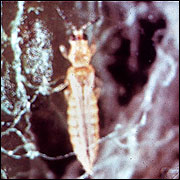 Figure 4
Figure 4
Thrips adult.
Identification and life cycle
These tiny, yellow to black, slender insects are annual pests in Missouri cotton fields (Figure 4). Thrips are active in the spring, feeding on wild host plants as well as cultivated plants, such as wheat. As these alternate host plants become less attractive, thrips begin migrating into adjacent cotton fields. Thrips have a generation (egg to adult) turnover of approximately two to three weeks with several generations occurring each year. Female thrips are each capable of laying 250 eggs during a two- to three-week period.
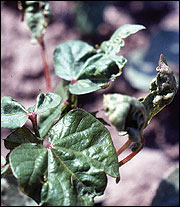 Figure 5
Figure 5
Thrips feeding damage. Note how the damaged leaves curl upward.
Damage
With their rasping-sucking mouthparts, thrips damage cotton by extracting plant juices from developing buds and foliage. Typical damage symptoms include leaves that are brown, wrinkled (spinach-like), or curled upward (Figure 5). Initially, thrips feeding damage reduces the plant's photosynthesis capacity and slows the plant's overall growth. A combination of reduced stand density, poor early-season crop growth, and delayed crop maturity can reduce overall cotton yields.
Control decisions
To scout for thrips, a cardboard box lined with white paper is recommended to spot these small insects (less than 1/20 inch in length) in the field. Place the box on the ground and angle it next to a group of cotton plants. Minimize the amount of soil that falls into the box so the thrips are easier to identify. Slap the plants over the box and count the small, slender, yellow to black thrips moving about in the box. Sample five plants at each of 10 random locations per field. Thrips infestations can be classified (damage and thrips infestation levels) as follows:
- None
- Low to new leaves with slight browning along edges; few thrips observed
- Medium to new leaves with considerable browning along edges and silvering on the underside; thrips common
- High to leaf silvering, terminal injury, deformed plants common; thrips numerous
Thrips injury usually ceases once plants reach the fourth leaf stage. A preventive, in-furrow insecticide application or seed treatment are the preferred methods of control. But preventive control measures are not always effective when cool, wet weather slows the seedling's uptake of insecticide treatments or during years of above average infestations. In these situations a rescue, foliar, insecticide application also may be required.
Note
Rescue treatments are recommended when thrips counts average one or more per plant.
Cutworms
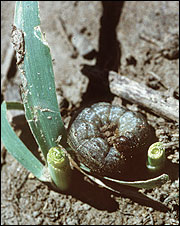 Figure 6
Figure 6
Cutworm larvae curl into a characteristic "C" shape when disturbed.
Identification and life cycle
Many cultivated (e.g., corn) and wild plant species are hosts for cutworms. Adult moths have mottled gray-brown forewings and light, uniform colored hindwings. Cutworm eggs are laid singly or in clusters of fewer than 30 next to plants and close to the ground. The larvae of the different cutworm species generally have a grayish coloration and will curl into a "C" shape when disturbed (Figure 6). The average life cycle (egg to moth) is approximately 30 days. Several generations may occur each year, but the first one is the most important economically.
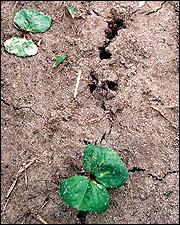 Figure 7
Figure 7
Cutworm feeding damage. Note the cut seedling near the larval burrows.
Damage
Typical larval damage includes stems girdled at the soil level or leaves clipped off (Figure 7). Plant stand reduction can delay crop maturity and reduce yields, and severe stand loss may require replanting of heavily damaged fields. Potential damage to seedling plants is greatest during cool, wet springs following mild winters. Cotton fields most susceptible to cutworm damage are those with legume cover crops or ones with reduced-tillage systems that have high levels of organic matter present.
Control decisions
An effective cultural practice to help minimize cutworm damage is to destroy any winter cover vegetation 14 days before the cotton is planted. Elimination of this cover vegetation increases the larva's risk of starvation and predation. Preventive insecticide treatments are not recommended because of sporadic infestations. Cutworm larvae actively feed at night and hide during the day in underground burrows or beneath dirt clods or leaf trash. To scout for cutworm infestations, look for wilted plants or ones cut at the ground level and dig beneath dirt clods to locate the larvae. This process should be repeated at 10 locations within a field.
Note
Rescue treatments are recommended to maintain a minimum plant stand density of three plants per row foot during years of abnormally high cutworm infestations.
Cotton aphid
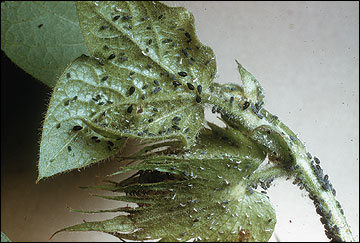 Figure 8
Figure 8
Cotton aphids.
Identification and life cycle
Cotton aphids are tiny, variable-colored (green, yellow or black), soft-bodied insects (Figure 8). Female aphids give birth to live young; therefore, a new generation can be produced every five days during the summer. As the season progresses, several generations can overlap in the field. Fortunately, a vast complex of beneficial insect parasitoids (small wasps) and predators (e.g., ladybird beetles, lacewing larvae) and diseases usually keep aphid populations below threshold levels.
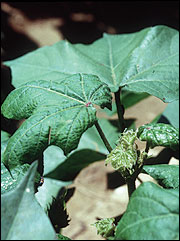 Figure 9
Figure 9
Cotton aphid feeding damage. Note how the damaged leaves curl downward.
Damage
Aphids use their piercing-sucking mouthparts to feed on cotton terminal buds and leaves. Feeding damage from severe aphid infestations can cause leaves to crinkle and curl downward (Figure 9), stunt or kill plants, and increase fruit loss. In addition to their feeding damage, aphids also deposit a sugary substance (honeydew) that serves as a growing medium for fungi (e.g., black mold). As the honeydew falls onto the lint, this moldy growth can stain the lint, reducing its quality and value.
Control decisions
To scout for aphids, examine the underside of leaves on five plants at each of 10 locations in a field. Aphid infestations can be classified as follows:
- Low to less than 10 aphids per leaf
- Medium to 11 to 25 aphids per leaf
- High to 26 or more aphids per leaf
Note
Rescue treatments are warranted when aphid infestations are medium to high, honeydew is present, and beneficial insects are scarce or absent.
Insecticides should be applied at maximum volume (five gallons by air and as many gallons as possible with ground rigs) with hollow-cone nozzles. The high water volume is necessary for thorough coverage of lower leaf surfaces where aphids feed. If one class of insecticide has been previously used in the field, a different class or combination of classes should be applied for subsequent aphid infestations. Cotton aphids have a history of insecticide resistance in Missouri and throughout the Cotton Belt. Since these insects reproduce so quickly, they are more likely to become physically tolerant of, or resistant to, an insecticide.
Cotton fleahopper, clouded plant bug, tarnished plant bug
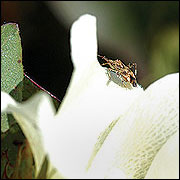 Figure 10
Figure 10
Clouded plant bug adult.
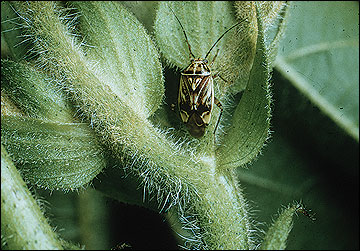 Figure 11
Figure 11
Tarnished plant bug adult.
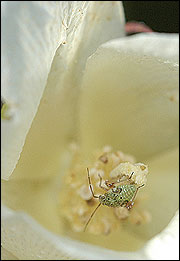 Figure 12
Figure 12
Tarnished plant bug nymph.
Identification and life cycle
The cotton fleahopper and both the clouded and tarnished plant bugs are generalist feeders that cause injury by extracting plant juices with their piercing-sucking mouthparts. Clouded plant bug adults have mottled coloration (gray, brown and yellow) and the first antennal segment is enlarged (Figure 10); whereas tarnished plant bug adults are yellowish brown with black and yellow lines and a distinctive V-shaped area at the base of their wings (Figure 11). Tarnished plant bug nymphs are green with distinctive black spots on their back (Figure 12). Cotton fleahoppers are pale green with tiny black spots and are smaller (1/8 inch vs. 1/4 inch in length) than plant bugs. In the spring tarnished plant bugs actively feed on many different cultivated (e.g., corn) and wild host plants (e.g., daisy fleabane) before moving into adjacent cotton fields. Plant bugs typically have a generation turnover of 20 to 30 days, and each female is capable of laying 30 to 70 eggs.
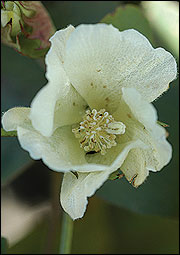 Figure 13
Figure 13
Plant bug feeding damage in a bloom.
Damage
Overall, the tarnished plant bug has the greatest potential to cause economic damage to cotton. Typical damage symptoms include square shed, deformed and brownish colored blooms, and stunted bolls (initially with reddish brown specks and later turning yellow) that the plant eventually sheds (Figure 13). Both square and boll shed also can occur due to environmental stresses (drought, overcast skies) or excessive plant populations (greater than 5 per foot of row) that cause carbohydrate stress in the plants; therefore, you should be certain that plant bugs are the primary cause of this fruit loss before applying any insecticide.
Control decisions
To scout for plant bugs, use a 15-inch diameter sweep net and a 3-foot drop cloth. Plant bug infestations generally begin along field border areas before the insects migrate further into the field. Their distribution also may be "clumped" near these border areas adjacent to their alternative plant hosts.
Note
Sweep nets are more effective in sampling for the adults; whereas the drop cloth is more useful for catching the nymphs. In each of 10 locations per field, sweep ten times and take one drop cloth sample.
Avoid taking sweep net counts during midday (11:30 a.m. to 3:30 p.m.) when plant bug adults are less active and deeper within the plant canopy. Scouting efforts for plant bugs should be intensified when square retention drops below 80 percent (first position sites) and before cotton plants start blooming. Treatment for plant bug infestations is particularly necessary during the first four weeks of squaring (late June to late July in Missouri). These fruiting positions are where the vast majority (greater than 80 percent) of the cotton lint is produced each year. Economic thresholds will vary according to plant's growth stage:
- 1 week of squaring
6 to 8 plant bugs per 100 feet of row - 2 week of squaring
8 to 10 plant bugs per 100 feet of row - 3 week of squaring
10 to 12 plant bugs per 100 feet of row - 4 week of squaring
>15 plant bugs per 100 feet of row
Mowing border vegetation around fields before cotton plants begin producing squares can help minimize the risk of plant bug infestations.
Cotton bollworm, tobacco budworm
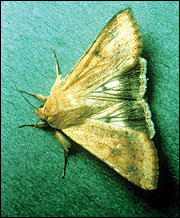 Figure 14
Figure 14
Cotton bollworm moth.
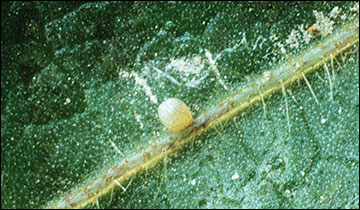
Figure 15
Bollworm egg.
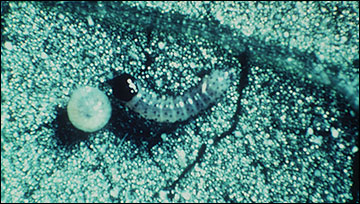 Figure 16
Figure 16
First-instar bollworm larva an egg.
Identification and life cycle
The cotton bollworm and the tobacco budworm are important caterpillar pests because of their potential feeding damage to squares and bolls; however, the cotton bollworm is usually the most common species each year in Missouri. Bollworm moths vary in color from reddish brown to a whitish green-brown (Figure 14); whereas, budworm moths are light green to brown with three darker green bands across the forewings. Female moths of both species usually lay their eggs (Figure 15) on the upper leaf surfaces in the terminal leaf bracts of fruiting forms, or blooms. The newly hatched larvae of both species are a whitish color with a black head (Figure 16). Larger larvae are light green to brown with several dark stripes down the body. Bollworm infestations may consist of both migratory and resident individuals, whereas tobacco budworm populations are primarily migratory. Annually, a majority (90 percent or more) of the larvae infesting Missouri cotton fields will be cotton bollworms. A generation is completed every 27 to 35 days with two to three generations occurring each year in cotton. A large complex of natural enemies readily attack both species unless eliminated or reduced by earlier insecticide applications. In the spring and early summer, cotton bollworm (the same insect as the corn earworm) feeds on alternative cultivated (e.g., corn) or wild host plants. Once these host plants mature and begin drying down, bollworm infestations shift to cotton.
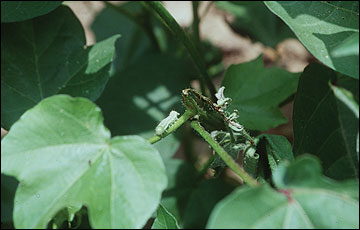 Figure 17a
Figure 17a
Bollworm terminal damage.
 Figure 17b
Figure 17b
Bollworm feeding on a square.
 Figure 17c
Figure 17c
Bollworm larva with frass in bloom.
 Figure 17d
Figure 17d
Bollworm larva and boll damage.
Damage
Newly hatched larvae initially feed on terminals (Figure 17a) or small squares (Figure 17b); however, larger larvae tend to move downward into the plant canopy to feed on blooms (Figure 17c), large squares, and bolls. A single larva is capable of destroying several squares (6 to 7) and bolls (2 to 3) before pupating (Figure 17d).
Control decisions
During the second week of squaring or once the first cotton blooms appear, examine plants at least once a week for feeding damage. When scouting for bollworm eggs and larvae it is important to examine the whole plant (particularly the top 3 to 5 inches of the main terminal) and its fruiting structures (particularly beneath bloom tags). Check five plants at each of 10 locations per field for eggs, larvae, and feeding damage (terminals wilted or fruit with holes and wet insect droppings present).
Note
Insecticide treatments are recommended when 10 percent of the plants are infested with small larvae (less than 1/4 inch in length).
Spider mites
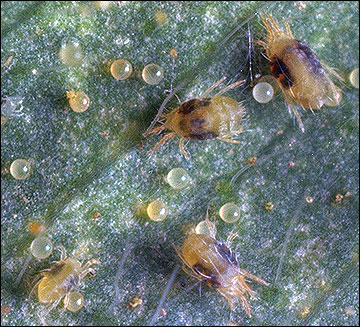 Figure 18
Figure 18
Two-spotted spider mite eggs, nymphs, and adults.
Identification and life cycle
The two-spotted spider mite (Figure 18) is the most common spider mite species attacking cotton. These tiny (less than 1/80 inch in length), variable-colored (green, tan or red) relatives of insects feed on multiple plant hosts. A generation is completed every four to 14 days with multiple generations occurring each year in cotton. Hot, dry conditions favor the most rapid development.
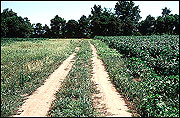 Figure 19
Figure 19
Border vegetation increases risk of mite infestations in the adjacent cotton field.
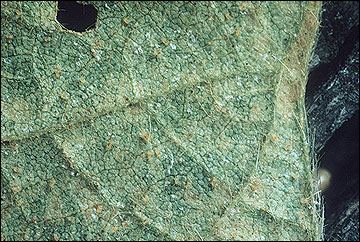 Figure 20
Figure 20
Spider mite webbing and leaf damage.
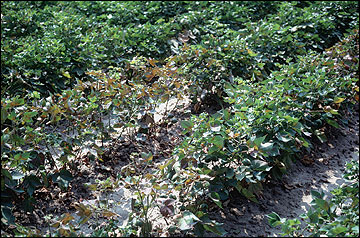 Figure 21
Figure 21
Spider mite feeding damage can weaken and even kill stressed plants.
Damage
Spider mite infestations in cotton fields generally start along field borders (Figure 19) and near ditches, weed patches, or dusty roads. Initially, spider mites start feeding along the leaf midrib before spreading across the leaf. As mite infestations increase and plants become more stressed by environmental factors (e.g., drought), small yellow spots appear on the infested leaves (Figure 20). Damaged leaves eventually turn a red color and die after prolonged mite feeding damage. Extensive spider mite damage can prematurely defoliate plants and dramatically reduce lint quantity and quality (Figure 21).
Control decisions
To scout for spider mites, examine at least one leaf from each of 50 randomly selected plants per field. Spider mite infestations can be classified as follows:
- None
- Low to 1 to 10 mites per leaf
- Medium to 11 to 25 mites per leaf
- High to 26 or more mites per leaf
Spot treating hot spots within a field with miticides can help reduce the risk of more widespread infestations.
Note
Miticide treatments are recommended once 50 percent or more of the plants are infested.
A second application within the next seven days is usually necessary because spider mite eggs are not killed by miticides. To obtain maximum control of spider mites, a miticide must be thoroughly applied to both sides of a leaf. Because spider mites are easily distributed from infested areas to non-infested ones by natural (animals, people, wind) or mechanical means, growers should maintain a vegetation-free zone of 10 to 20 feet in width between the cotton and border vegetation to minimize spider mite infestations. Preserving beneficial insects (e.g., big-eyed bug, minute pirate bug) can help minimize spider mite infestations.
Fall armyworm
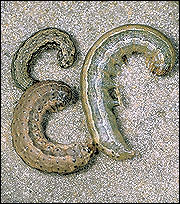 Figure 22
Figure 22
Fall armyworm larvae.
Identification and life cycle
This armyworm species may prefer grass hosts; however, it also feeds on broadleaf plants like cotton. Fall armyworm is an infrequent economic pest in cotton, but it can potentially cause substantial boll damage in Missouri. Adult moths have mottled forewings, and the hindwings are whitish with a gray border. Small larvae are white with black heads; whereas larger larvae are dark and smooth, with an inverted "Y" mark on their cream-colored heads (Figure 22 ). Fall armyworms have a generation turnover of 24 to 35 days, and several generations can occur each year in Missouri; however, there is generally only one generation in cotton. Female moths are capable of laying 50 to several hundred eggs in masses covered with the grayish moth scales.
 Figure 23
Figure 23
Fall armyworm boll damage.
Damage
Infestations usually occur once alternate host plants (e.g., corn) mature and dry down. Typical damage symptoms are blooms and bolls with holes at the base of the bracts (Figure 23).
Control decisions
To scout for fall armyworm infestations, examine five plants at each of 10 locations per field for egg masses, larvae or damage. These egg masses are typically laid on both sides of the leaf. The larvae are difficult to detect because they start feeding on the boll exterior within a few days of hatching from their eggs.
Note
Insecticide treatments are recommended when four or more larvae per 100 bolls or blooms are present.
Beet armyworm
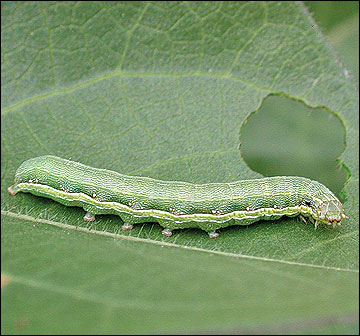 Figure 24
Figure 24
Beet armyworm larva.
Identification and life cycle
Beet armyworms are a migratory species that infrequently infests Missouri cotton fields. They have a wide range of hosts but favor broadleaf plants (e.g., cocklebur, cotton, pigweed). Adult beet armyworm moths are grayish with a pinkish white dot in the center of each forewing, and the hindwings have a dark border. The smoothed-skin larvae have variable coloration but all have a distinctive black dot on either side of the body and above the second pair of true legs (Figure 24). Beet armyworms have a generation turnover of 27 to 36 days, but there is typically only one generation in cotton. Female moths are capable of laying 80 to 150 eggs in masses covered with the grayish moth scales.
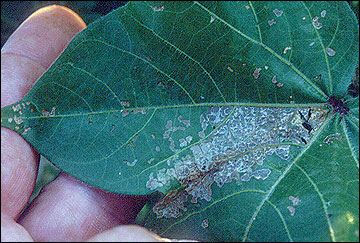 Figure 25
Figure 25
Beet armyworm feeding damage. Note that the larvae do not chew through the leaf.
Damage
Typical damage symptoms in cotton initially begin with "skeletonized" leaves (Figure 25) followed by damage to squares, blooms, and bolls. Also take note of any foliar damage to weed hosts (e.g., pigweed) also present in the field.
Control decisions
To scout for beet armyworm infestations, examine five plants at each of 10 locations per field for egg masses, larvae or damage. Egg masses are typically laid on both sides of the leaf.
Note
Insecticide treatments are recommended when 5 to 6 "hits" (egg masses or larval clusters) per 300 row feet are found before Aug. 15. This threshold doubles after Aug. 15.
Management practices to minimize beet armyworm infestations include:
- Early crop maturity
- Proper weed (e.g., pigweed) control
- Preservation of beneficial insects.
Banded-wing whiteflies
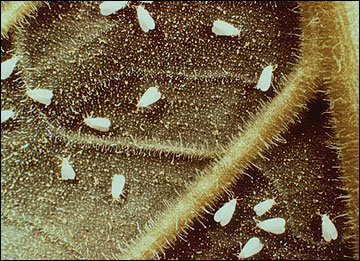 Figure 26
Figure 26
Whitefly adults.
Identification and life cycle
Banded-wing whiteflies are small, piercing-sucking insects that occasionally reach economic infestation levels in Missouri. Adult whiteflies are snowy white (Figure 26) with three narrow wing bands; whereas, the nymphs are pale green and have an oval shape. Whiteflies have a rapid (about 18 days) life cycle (egg to adult), and several overlapping generations may occur in cotton. Many predaceous (e.g., ladybird beetles) and parasitic insects readily attack and suppress whitefly infestations unless eliminated by earlier insecticide applications.
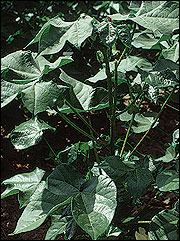 Figure 27
Figure 27
Honeydew-laden leaves (shiny) from whitefly infestation.
Damage
Whitefly feeding damage can cause premature defoliation and poor boll development. Their honeydew deposits (Figure 27) may eventually lead to staining of the cotton lint as black sooty mold grows on the contaminated lint.
Control decisions
To scout for whiteflies, examine five plant terminals at each of 10 locations per field. Take note of the number of whitefly colonies resting on the underside of leaves or flying about as you walk through the field.
Note
Insecticide treatments are recommended when 50 percent or more of the plant terminals are infested.
Thorough coverage of the entire plant canopy is necessary for adequate whitefly control.
European corn borer
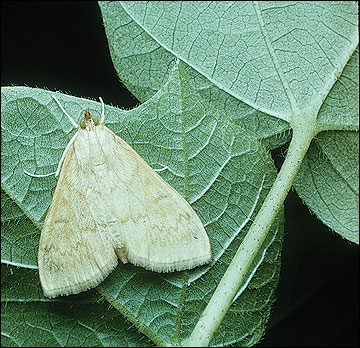 Figure 28
Figure 28
European corn borer moth.
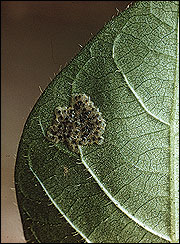 Figure 29
Figure 29
European corn borer egg mass.
Identification and life cycle
This pest species has a wide host range, but it can be an infrequent cotton pest by damaging terminals and even mature bolls. Female moths are pale-yellow with irregular, wavy bands on their wings (Figure 28). Males are smaller, darker, and have olive-brown wing markings. Larvae are initially dull white with small brown spots arranged in rows, but older larvae are light tan to a pinkish gray with two rows of small, circular, brown spots. The European corn borer has a generation turnover of greater than 30 days, but only one generation is of economic importance in Missouri cotton fields. Female moths typically lay 5 to 50 eggs in masses on the underside of leaves (Figure 29).
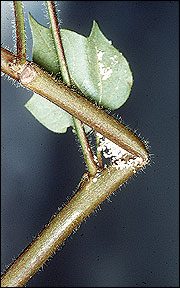 Figure 30
Figure 30
European corn borer stem damage.
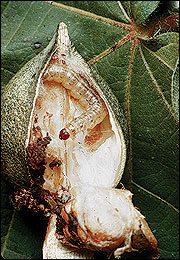 Figure 31
Figure 31
European corn borer larva and boll damage.
Damage
Infestations usually occur once alternative host plants (e.g., corn) mature and dry down. Typical damage symptoms in cotton are terminals (Figure 30) and bolls (Figure 31) with holes and sawdust-like droppings around the hole.
Control decisions
To scout for European corn borer infestations, examine five plants at each of 10 locations per field for larvae and feeding damage. Female moths readily penetrate deep into the canopy; therefore, the entire plant should be examined. Typically, European corn borer larvae bore into the bottom of the boll; whereas, cotton bollworm or tobacco budworm larvae initially bore further up and into the boll. Look for the small larvae between the bracts and boll wall.
Note
Currently, Missouri has no established threshold for this pest on cotton. In North Carolina, a recommended threshold is 3 percent or more of the plants infested with young live larvae.
Growers can minimize the attractiveness of their cotton to European corn borers with early planting dates and uniform plant growth.
Loopers
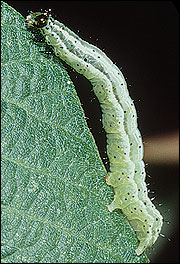 Figure 32
Figure 32
Looper larva.
Identification and life cycle
Two looper species (cabbage and soybean) may infest cotton fields, but the migratory soybean looper is rarely observed in Missouri. Looper moths have brown to gray forewings with a silver figure-eight design and lighter-colored hindwings with dark margins. The larvae are initially white before turning a pale green color. The larvae are easily identified by their looping gait (Figure 32). Looper larvae feed entirely on foliage for 14 to 28 days.
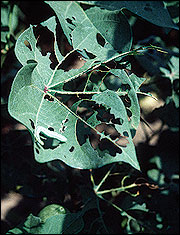 Figure 33
Figure 33
Looper foliar damage. Main leaf veins are left intact.
Damage
Typical damage symptoms are leaves with ragged holes with the leaf veins still intact (Figure 33).
Control decisions
To scout for looper infestations, examine five plants at each of 10 locations per field for defoliation damage. Premature defoliation by loopers is rare because diseases and natural enemies usually suppress looper infestations.
Note
Insecticide treatments are recommended once defoliation damage reaches 25 percent and developing bolls are still present.
Stink bugs
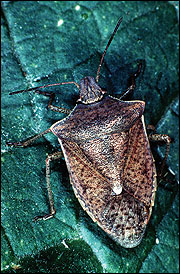 Figure 34
Figure 34
Stink bug adult.
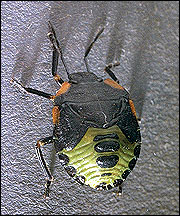 Figure 35
Figure 35
Green stink bug nymph.
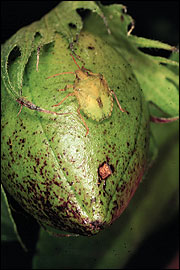 Figure 36
Figure 36
Brown stink bug nymph.
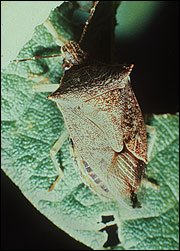 Figure 37
Figure 37
Spined soldier bug adult.
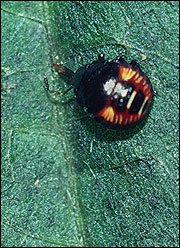 Figure 38
Figure 38
Spined soldier bug nymph.
Identification and life cycle
Both green and several species of brown stink bugs may feed on cotton. Stink bugs also feed on many other cultivated (e.g., corn, soybean) and wild host plants. Adult stink bugs are shield-shaped and their coloration is indicative of their name (Figure 34). Green stink bug nymphs are initially black and later turn green with orange and black markings (Figure 35). Brown stink bug nymphs are light green with no distinctive markings (Figure 36). Not all stink bug species are considered pests, and one predatory species looks similar to brown stink bugs. Adult spined soldier bugs differ from brown stink bugs by having more pronounced spines behind their head and a reddish underside with a black spot near the tip of the abdomen (Figure 37). Spined soldier bug nymphs are initially red and black but later turn a creamy yellowish orange coloration (Figure 38).
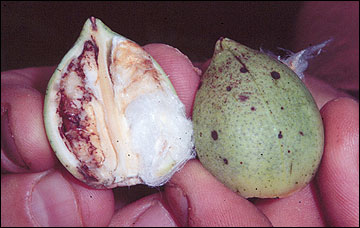 Figure 39
Figure 39
Stink bug boll damage.
Damage
Stink bugs are robust insects that use their piercing-sucking mouthparts to remove plant fluids from squares and bolls. Stink bugs can damage even relatively mature bolls (Figure 39). External damage: small, sunken, black spots; Internal damage: discolored lint and seeds, "warty" growth on boll wall); however, economic infestations are sporadic in Missouri.
Control decisions
To scout for stink bug infestations, use a drop cloth and take beat samples at 10 different locations in a field. Also, open a few bolls and inspect the bolls for signs of stained lint and seeds. Because their eggs are laid in masses, infestations are rarely uniform across a field.
Note
Insecticide treatments are recommended when stink bug infestations reach one large nymph or adult per 6 row feet, or when 20 percent of medium-sized bolls display internal signs of feeding damage and stink bugs are observed.
Other cotton insect pests
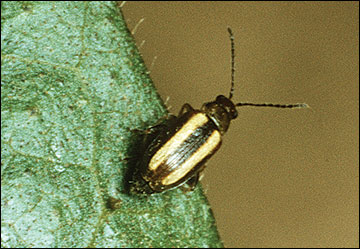 Figure 40
Figure 40
Flea beetle adult.
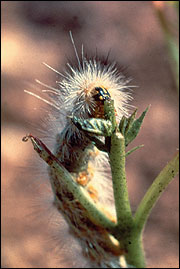 Figure 41
Figure 41
Saltmarsh caterpillar larva.
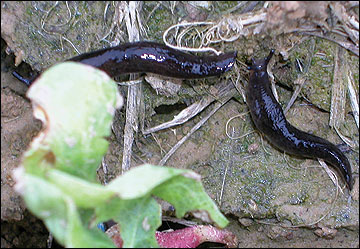 Figure 42
Figure 42
Slugs and slime trail.
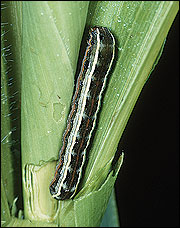 Figure 43
Figure 43
Yellowstriped armyworm.
Identification and life cycle
Cotton is host to many other plant-feeding insects and invertebrates (e.g., flea beetles, leafrollers, saltmarsh caterpillar, slugs, yellowstriped armyworm) that are rarely considered a pest of cotton. However, they have the potential to become pests under special circumstances. Flea beetles are small, shiny, dark-colored insects that have a third pair of legs enlarged for jumping (Figure 40). The variegated leafroller is one of several species of leafroller that may infest cotton fields. The variegated leafroller has an apple-green coloration on top and is amber green on the bottom. The saltmarsh caterpillar larva is covered in long hairs (red or black) and its body is initially gray after hatching; then it turns yellow to black as it matures (Figure 41). Slugs are soft-bodied, legless invertebrates without shells and leave a slime trail as they move about in the field (Figure 42). Yellowstriped armyworm larvae have two rows of black, triangular spots along the back between thin yellow lines (Figure 43).
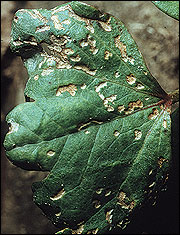 Figure 44
Figure 44
Flea beetle damage to cotyledons.
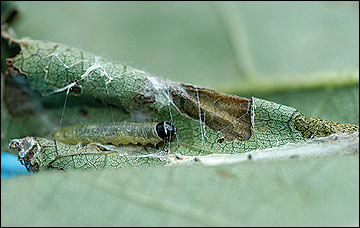 Figure 45
Figure 45
Leafroller and rolled leaf.
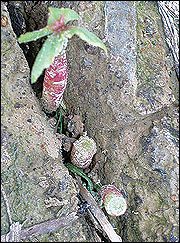 Figure 46
Figure 46
Slugs damage to seedlings.
Damage
Flea beetle adults occasionally attack plants at the seedling stage and remove the green tissue from the leaves, particularly the cotyledon leaves (Figure 44). This damage most often occurs in no-till fields where the cover vegetation was killed off after the cotton plants emerged. Leafrollers feed on many parts of the cotton plant, but the bracts of fruiting forms (squares, blooms and bolls) are typically the favored feeding sites. Leafrollers spin a web and feed on the plant tissue within this protective "shell" (Figure 45). The presence of extensive webbing helps distinguish leafroller damage to boll walls from that caused by fall armyworm larvae. Early-season infestations of saltmarsh caterpillars are a threat primarily when they destroy the terminal of two-leaf or smaller plants, whereas loopers and other late-season infestations that feed on leaves are much less of a threat. Slugs are another pest primarily found in no-till fields. Slugs may feed on the cotyledon leaves of small plants or clip the plants like cutworm larvae do (Figure 46). Yellowstriped armyworms are primarily an early-season pest that can destroy young plants, but they also may feed on squares and bolls later in the season.
Control decisions
No threshold exists for flea beetles because economic infestations of this insect are rare; however, insecticide oversprays for cutworms in no-till fields also should control any flea beetles feeding in those same fields. Leafroller infestations only occur in non-Bt fields, and insecticide oversprays are not recommended unless early-season terminal damage reaches 20 percent in presquaring cotton. The saltmarsh caterpillar is another pest primarily found in no-till fields. No threshold exists for saltmarsh caterpillars, and late-season foliar damage should be pooled with similar damage caused by loopers. Beneficial insects typically control these late-season saltmarsh caterpillar infestations. Slug infestations currently have no action threshold on cotton. Generally, slug populations decline as weather conditions turn drier and warmer, and subsequent plant growth compensates for any slug feeding damage. There is no threshold for yellowstriped armyworms in cotton because economic infestations are rare; however, insecticide oversprays for other early-season (e.g., cutworms) and late-season (e.g., bollworm) pest infestations also should control yellowstriped armyworm infestations.